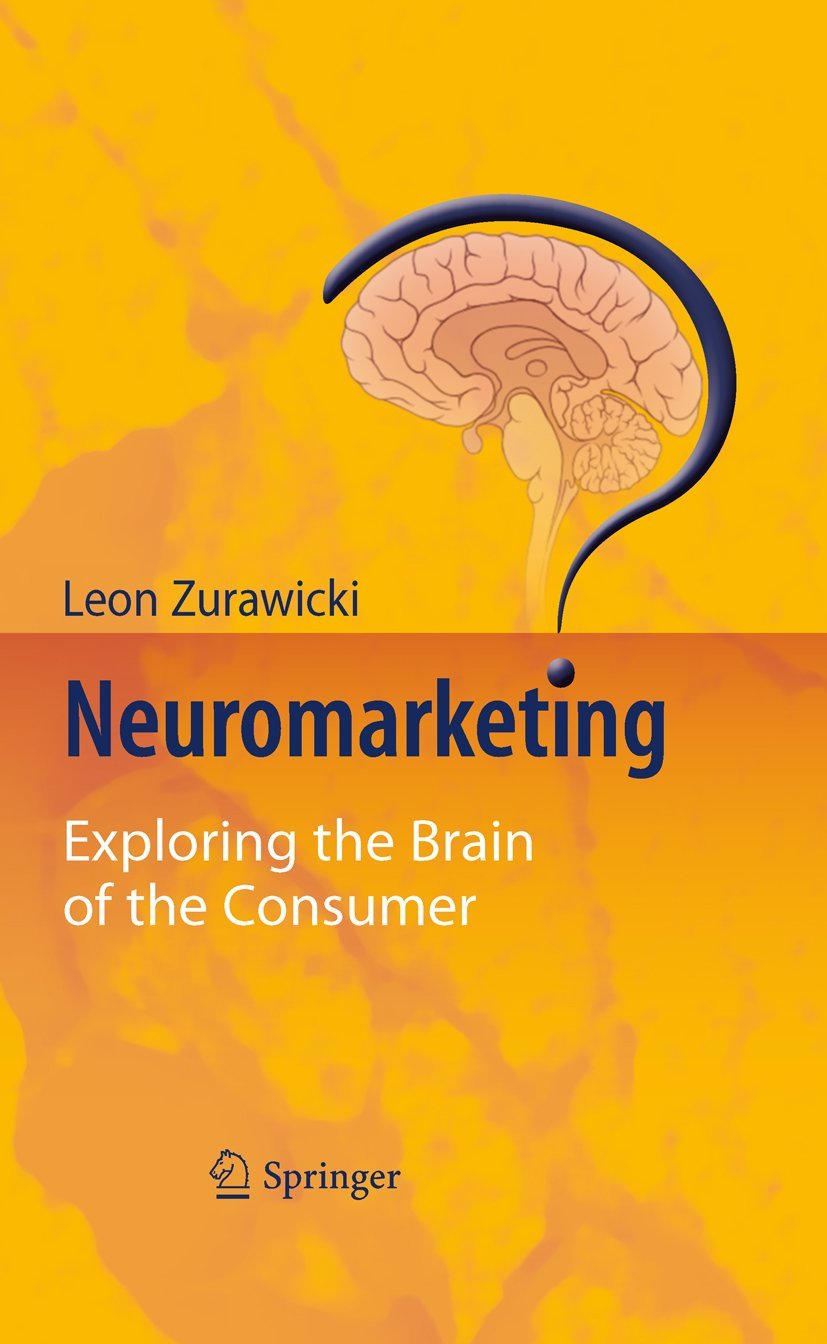2012 NeuroPsychoEconomics Conference Experience
 The NeuroPsychoEconomics Conference is the official annual event of the Association of NeuroPsychoEconomics. The Association for NeuroPsychoEconomics is a strategic partner of the American Psychological Association (APA) and the premier scholarly organization for scientists and professionals in neuroscience, psychology, business, marketing, and economics.
The NeuroPsychoEconomics Conference is the official annual event of the Association of NeuroPsychoEconomics. The Association for NeuroPsychoEconomics is a strategic partner of the American Psychological Association (APA) and the premier scholarly organization for scientists and professionals in neuroscience, psychology, business, marketing, and economics.2012 NeuroPsychoEconomics Conference was held from June 14th to June 15th at Erasmus University, Rotterdam School of Management, in Netherlands. The conference chair was Ale Smidts, Professor of Marketing Research at the Rotterdam School of Management. The conference theme was “Integrating Neuroscience with Research on Economics, Management, and Marketing“.
Pre-conference workshops on ‘Advances in Neuroscientific Methods’ were held on the first day (June 14th). This tutorial offered lectures on fMRI (Erno Hermans), EEG (Maarten Boksem), TMS (Lennart Verhagen), hormones (Sina Radke), genetics (Daniel von Rhein), by leading researchers from the Donders Institute for Brain, Cognition and Behaviour (Radboud University Nijmegen):
The second day of the conference (15th of June) started with a welcome note by the conference chart Prof. Ale Smidts:
Presentations started with a key note speech from John O’Doherty (California Institute of Technology – Pasadena, California, USA) on Neural mechanisms underlying valuation and decision-making in social contexts.
Neural mechanisms for valuation of social stimuli depend on neural circuitry overlapping with that involved in mediating similar processes in non-social contexts (most prominently in the vmPFC). Also, valuation mechanisms in vmPFC and elsewhere are strongly modulated by social contextual variables: one’s own expectations regarding a social interaction and social preferences (inequality aversion, social comparison, etc.).
Neural mechanisms for learning in social contexts also depend on similar computational mechanisms and neural structures than used for learning in non-social scenarios. However, in more complex scenarios in which decision-making requires strategic thinking – the capacity to infer about the behavior and intentions of another: additional neural circuits are recruited: the so-called theory of mind or “mentalizing network”.
Decisions made in social contexts also appear to depend largely on broadly similar circuits to that involved in non-social contexts. However, once again, when decisions depend on the need to render inferences about others’ likely behavior, additional circuitry appears to be recruited (once again theory of mind network). Distinction between neural circuits recruited in social compared to non-social contexts might be largely due to differences in the computational complexity inherent to these different scenarios.
One of his studies (published in 2003) on social reward used images of faces (face forward, eye-gaze forward, matched for eye position, conditions with neutral to mildly happy face expressions) with a different level of attractiveness as stimuli (12 ‘High attractive’ males, 12 ‘low attractive’ males, 12 ‘high attractive’ females, 12 ‘low attractive’ females). Images were shown for 1.5 seconds each, and each stimulus (image) was repeated 4 times (48 x 4 = 196 stimuli presented).
A current study that Prof. O’Doherty conducts is focused on value perceived during real social interactions. Together with Jeff Cooper, he evaluates social interactions during speed dating using fMRI. As a pre-date evaluation, subjects evaluate potential artners based on facial appereance, and after the speed dating is finished, they reveal all decisions (yes/no) while they are scanned. I’m looking forward to reading the results of this study.
A recent study (published in 2010) studies the social-modulation of valuation for high- and low-pay subjects, and their willingness to transfer to self or others (see photos below). Studies also concluded that monetary rewards are modulated by social variables / context.
- Startle reflex modulation enriches the methodological spectrum in consumer neuroscience (Koller, Walla):
- Gist-based predictors of risky behavior and problem outcomes (Wilhelms, Brust-Renck, Corbin, Reyna, Liberali):
- Cultural differences in social discounting (Strombach, Weber, Kenning, Ma, Shen, Jin, Kalenscher)
- What eating popcorn has to do with playing tennis: decoding preferences across consumption categories (Woelbert, Gross, Zimmermann, Barth, Riedl, Goebel)
- The neural substrates of maternal love in shopping: mother’s willingness to pay for her child vs. for herself measured by fMRI (Yeh, Kung)
- Weird or wired celebrities: effects of celebrity endorsers in energy-commercials on psychophysiological response patterns (Opwis, Schmidt, Lambeck, Stuermer)
- Affect and decision making across the adult lifespan (Nagel, Mohr, Li, Heekeren)
- To trust or not to trust? Ingroup and outgroup membership in Chinese and Italians (Morese, Rabellino, Ciaramidaro, Elena, Bara, Bosco)
- Social status and financial risk-taking: brain evidence for cross-context influences (Schoots, Boksem, Sanfey, Smidts)
- Physio-heatmaps: visualizing complex psychophysiological assessment of market research stimuli (Schmidt, Opwis, Stuermer)
- Predicting purchase behaviour with EEG (Neural predictors of purchase-behaviour from EEG during passive viewing of products) (Pouw, Boksem, Smidts)
- Social learning of trust (Ratala, Chang, Cetinkaya, Sanfey)
- Third party punishment in in-group & out-group settings: a comparison between Italians and Chinese (Rabellino, Morese, Ciaramidaro, Bara, Rosato, Bosco)
- White matter asymetry predicts domain-specific risk perception but not risk taking: insights from diffusion tensor imaging (Buerger, Schoene-Bake, Johnson, Weber, Weber)
- The neural correlates of time versus money in product evaluation (Lehmann, Reimann)
- Taking the pulse of the market: a consumer’s decision-making algorithm using insights from neuromarketing research (Bercea)
- How companies motivate entrepreneurial employees: the case of organizational spin-alongs (Klarner, Michl, Picot)
- Effort increases sensitivity to reward and loss magnitude in the human brain (Fliessbach, Lallement, Kuss, Trautner, Falk)
- Financial decision making across the adult life span (Mohr, Nagel, Li, Heekeren)
- The predictive value of the 2D:4D digit ratio for performance and competitive behavior in a real effort experiemnt (Mertins)
- Neural predictors of risky behaviour (Losecaat Vermeer, Boksem, Sanfey)
- Temporal discounting and number cognition (Alonso Diaz)
- The impact of implicit motives on the decision-making process: a hypothesis for the business to business sector (Chlupsa)
- Emotional aspects of decision-making process: the thermodynamic approach (Pakhomov, Sudjin)

With Leon Zurawicki (Professor at University of Massachusetts – Boston; author of Neuromarketing: Exploring the Brain of the Consumer) and Ding-Ruey Yeh

Leon Zurawicki and people from The Neuromarketing Labs
Track: Regulating Emotions in Financial Decision Making (I attended this one)
Track chair: Daniel Houser (George Mason University)
- Emotion regulation and trader expertise: heart rate variability on the trading floor (Fenton-O’Creevy, Lins, Vohra, Richards, Davies, Schaaff)
Prof. Mark Fenton-O’Creevy (Open University, UK) described a psychophysiological study of the emotion regulation of investment bank traders. Building on work on the role of emotions in financial decision-making, he examined the relationshipbetween market conditions, trader experience and emotion regulation whilst, as indexed by high frequency heart rate variability. He suggests that emotion regulation may be an important facet of trader expertise and that learning effects demonstrated in financial markets may include improved emotion regulation as an important component of that learning. He also suggests the value of investigating the role of effective emotion regulation in a broader range of financial decision-making contexts.
- Paying attention to emotions pays off: emotion regulation training improves financial decision-making (van Overveld, Mehta, Smidts, Figner, Lins)
Mark van Overveld (Erasmus University of Rotterdam, The Netherlands) states that as recent evidenc suggests that emotions are important factors that could facilitate decision-making, learning to regulate emotions effectively could help improve (financial) decision-making. So midfulness training aims at improvements in emotion regulation, attention and awareness (and reduces anxiety and depression). In a series of three studies they examined whether mindfulness is associated with financial decision-making. Results showed that mindfulness is an effective method to learn to regulate emotions and associated with improvements in financial decision-making, both in lay decision-makers and in professional decision-makers.
- Influence of emotional pictures on bidding behavior (Astor, Adam, Krämer)
In their study, Philipp Astor et al. conducted a series of first-price sealed-bid auctions in a controlled laboratory experiment. Bidders’ were presented either pictures of sports scenes, pictures of families and lovers or no pictures (blank screen) immediately before placing their bid (pictures were retrieved from the international affective picture system (IAPS)). Throughout the experiemnt they measured bidders’ heart rate and electrodermal activity (well known correlates of emotional processing). They found out that not only the bidders’ emotional reactions, but also their bids differ significantly between the three treatments; also, subjects using predominantly suppression strategies are especially susceptible to the display of pictures. The bids also correlate with the prespecified valence ratings of the single IAPS pictures, where high ratings result in higher bids. This was also supported by the finding that bids correlate with bidder’s valence (average decrease in heart rate), which is an established psycho-physiological response of implicit picture processing.
- Joy leads to overconfidence – and a simple remedy (Koellinger, Michl)
As the literature reveals that moods influence judgements in a mood-congruent manner and the precision of judgement seems to depend on the stakes at play, joy is a potential transient cause of overconfidence. In the experiment, Theresa Michl used a general knowledge task of medium difficulty to measure confidence. The results report that joy indeed increases the tendency to be overconfident and that making an irrelevant cause of joy salient to people (i.e. by showing them a humorous movie clip) leads to well-calibrated judgements.
- Implementation intentions as self-regulation enhancer to overcome the seduction of impulsive buying (Kopton, Preilowski, Kenning)
Isabela Kompton presented a study that provides empirical evidence on the moderating effects of implementation intentions for both low- and high-level impulsive buyers. Electroderman activity data indicate also that especially for high-level impulsive buyers who are generally under-aroused during their buying decisions, cue-specific processing can increase the arousal level.

Isabella Kopton – Implementation intentions as self-regulation enhancer to overcome the seduction of impulsive buying

Isabella Kopton – Implementation intentions as self-regulation enhancer to overcome the seduction of impulsive buying
Track: Decision Neuroscience & Aging
Track chair: Monika Koller (WU Vienna)
- Decision making and error monitoring in elderly employees (Gajewski, Frießem, Zülch, Falkenstein)
- Should I gamble or not? On the relationship between decision making under uncertainty, brain function, and age (Sproten, Sharvit, Diener, Fiebach, Schwieren)
- Does the association of age with loss aversion have a neural basis? (Viswanathan, Lee, Gilman, Raman, Kim, Lee, Schultz, Kuster, Carey, Calder, Mulhern, Breiter)
- The relationship between personality and illness: a TCI metaanalysis (Sohn, Kaltenegger, Schoeffski)
- The entrepreneurial personality: lessons for student’s education (Huber, Poech, Brodie)
- Neuroeconomics & Behavioral economics
- Consumer Neuroscience, Psychology, and Behavior
- Decision Neuroscience & Organizational Behavior
Track: Social Neuroscience: Cooperation, Trust & Hormones
Track chair: Theresa Michl (Ludwig Maximilan University Munich)
- Social risk and ambiguity preferences in trust decision (Fairley, Sanfey, Vyrastekova, Weitzel)
- Temptation to free ride under uncertain punishment is ameliorated by behavioural inhibition (Skatova, Ferguson)
- Can genotype predict player type? (Mertins, Schote, Meyer)
- The impact of testosterone administration on trust, risk, betrayal, and reciprocity (Boksem, Mehta, van den Bergh, van Son, Sanfey, Smidts)
- The herding hormone: oxytocin motivates in-group conformity (Stallen, De Dreu, Shalvi, Smidts, Sanfey)
Track: Decision Neuroscience & Behavioral Economics
Track chair: Klaus Fliessbach (University Hospital Bonn)
- Do people have a preference for increasing or decreasing pain? An experimental comparison of psychological and economic measures in health related decision making (Kroll, Trarbach, Vogt)
- Individual differences in self control in a time discounting task (Waegeman, Declerck, Boone, Van Hecke, Parizel)
- Variations in the experience of anticipation and corresponding neural activation (Calder, Viswanathan, Kuster, Kim, Raman, Block, Caywood, Lee, Gilman, Mulhern, Blood, Breiter)
- Depression, media usage and purchase behavior (Block, Blood, Caywood, Lee, Carey, Cho, Shalowitz, Breiter, Mulhern, Calder, Schultz)
- Opening the “black box” of electroderman activity in consumer neuroscience research (Lajante, Droulers, Dondaine, Amarantini)
Mathieu Lajante identified a series of methods for collecting and processing the electroderman activity signal, offering some recommendations. He also ilustrated an empirical study on conducted on 7 TV commercials; results showe that applying new processing techniques based on the deconvolution of the signal improves the robustness of measures thus contributing to the enhancement of work in consumer neuroscience.
Track: Consumer Behavior & Neuromarketing (I attended this one)
Track chair: Marco Hubert (Zeppelin University)
- Merging neuromarketing into practice (Zurawicki)
Leon Zurawicki stated that the challenge for the academic community is to come up with the research agenda which allows theory testing in a practical setting (not lab conditions) and at the same time to be willing to solve companies’ specific problems. He also proposed to test the repertory of emotional pictures, sounds, words and even scents in the context of marketing messages. The available brain-sensing, facial coding and biomarking technology should help validify the key components of such representations and in the form of an expert system assist managers in the execution of communication strategies.
- National brands versus own-label brands: the influence of price and respective neural imprints (Santos, Martins, Ferreira, Ramalho, Seixas)
- Neural correlates of consumer response to cause-related marketing – Heterogeneous effect of cause-related marketing in corporate crisis management (Jo, Kim, Jeong)
- Evaluating the concept of “image-in-use” based on biological information (Shirahada, Suzuki, Kosaka)
- Don’t treat others better than me: drivers and outcomes of customer envy (Wobker, Kenning)
The conference ended with a good bye note from Prof. Ale Smidts:




















































































































































Thank you very much to send this great report. I hope to see you soon in another conference.
Best regards
Mathieu Lajante
Hi, Matheiu! Thank you for your appreciation, I also hope to meet you again at conferences, good luck in your work, let me know when you publish!
Kind regards,
Monica